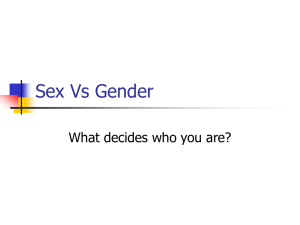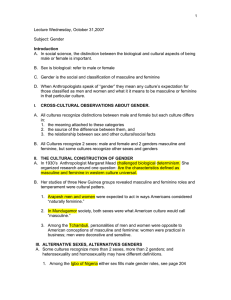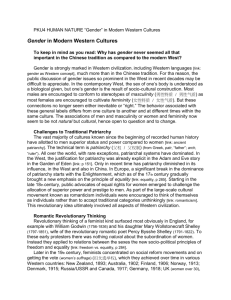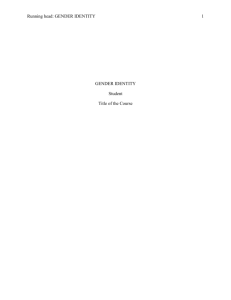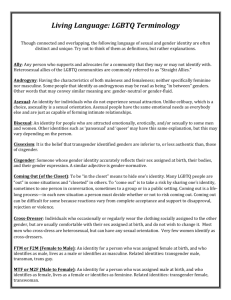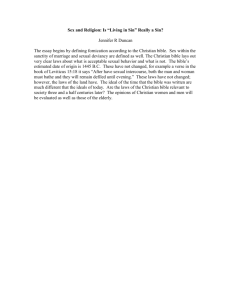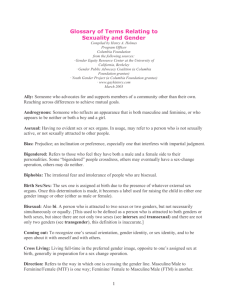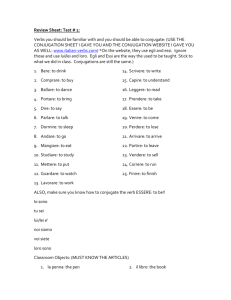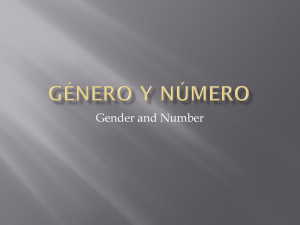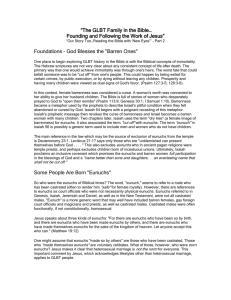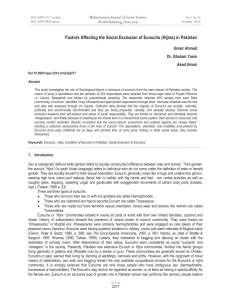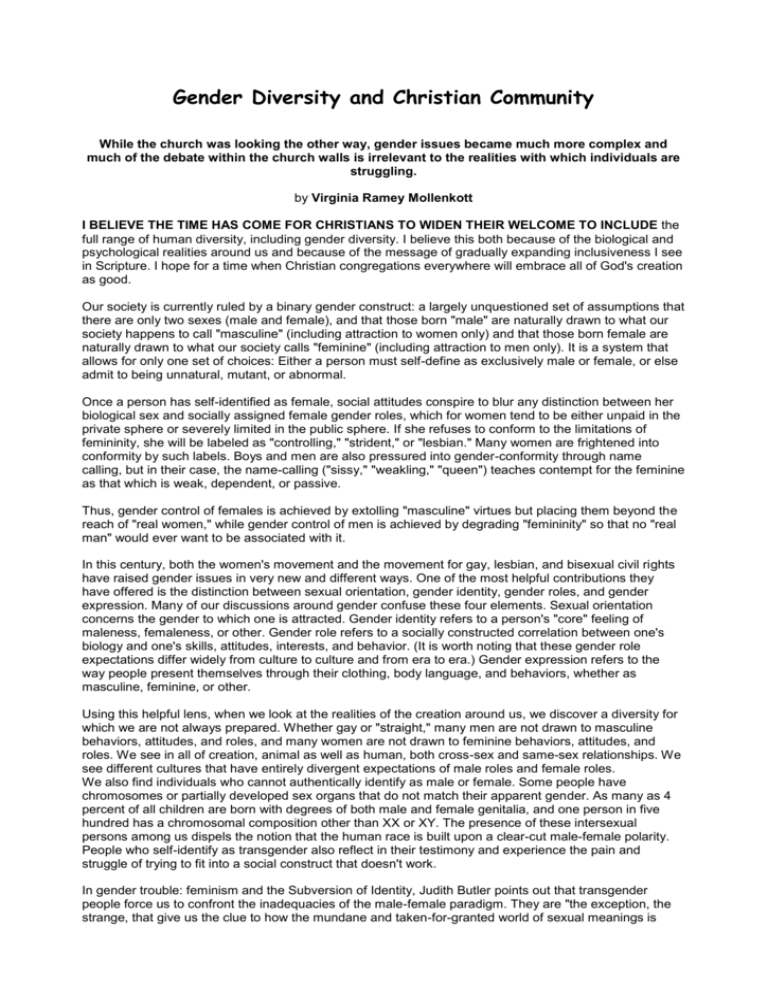
Gender Diversity and Christian Community
While the church was looking the other way, gender issues became much more complex and
much of the debate within the church walls is irrelevant to the realities with which individuals are
struggling.
by Virginia Ramey Mollenkott
I BELIEVE THE TIME HAS COME FOR CHRISTIANS TO WIDEN THEIR WELCOME TO INCLUDE the
full range of human diversity, including gender diversity. I believe this both because of the biological and
psychological realities around us and because of the message of gradually expanding inclusiveness I see
in Scripture. I hope for a time when Christian congregations everywhere will embrace all of God's creation
as good.
Our society is currently ruled by a binary gender construct: a largely unquestioned set of assumptions that
there are only two sexes (male and female), and that those born "male" are naturally drawn to what our
society happens to call "masculine" (including attraction to women only) and that those born female are
naturally drawn to what our society calls "feminine" (including attraction to men only). It is a system that
allows for only one set of choices: Either a person must self-define as exclusively male or female, or else
admit to being unnatural, mutant, or abnormal.
Once a person has self-identified as female, social attitudes conspire to blur any distinction between her
biological sex and socially assigned female gender roles, which for women tend to be either unpaid in the
private sphere or severely limited in the public sphere. If she refuses to conform to the limitations of
femininity, she will be labeled as "controlling," "strident," or "lesbian." Many women are frightened into
conformity by such labels. Boys and men are also pressured into gender-conformity through name
calling, but in their case, the name-calling ("sissy," "weakling," "queen") teaches contempt for the feminine
as that which is weak, dependent, or passive.
Thus, gender control of females is achieved by extolling "masculine" virtues but placing them beyond the
reach of "real women," while gender control of men is achieved by degrading "femininity" so that no "real
man" would ever want to be associated with it.
In this century, both the women's movement and the movement for gay, lesbian, and bisexual civil rights
have raised gender issues in very new and different ways. One of the most helpful contributions they
have offered is the distinction between sexual orientation, gender identity, gender roles, and gender
expression. Many of our discussions around gender confuse these four elements. Sexual orientation
concerns the gender to which one is attracted. Gender identity refers to a person's "core" feeling of
maleness, femaleness, or other. Gender role refers to a socially constructed correlation between one's
biology and one's skills, attitudes, interests, and behavior. (It is worth noting that these gender role
expectations differ widely from culture to culture and from era to era.) Gender expression refers to the
way people present themselves through their clothing, body language, and behaviors, whether as
masculine, feminine, or other.
Using this helpful lens, when we look at the realities of the creation around us, we discover a diversity for
which we are not always prepared. Whether gay or "straight," many men are not drawn to masculine
behaviors, attitudes, and roles, and many women are not drawn to feminine behaviors, attitudes, and
roles. We see in all of creation, animal as well as human, both cross-sex and same-sex relationships. We
see different cultures that have entirely divergent expectations of male roles and female roles.
We also find individuals who cannot authentically identify as male or female. Some people have
chromosomes or partially developed sex organs that do not match their apparent gender. As many as 4
percent of all children are born with degrees of both male and female genitalia, and one person in five
hundred has a chromosomal composition other than XX or XY. The presence of these intersexual
persons among us dispels the notion that the human race is built upon a clear-cut male-female polarity.
People who self-identify as transgender also reflect in their testimony and experience the pain and
struggle of trying to fit into a social construct that doesn't work.
In gender trouble: feminism and the Subversion of Identity, Judith Butler points out that transgender
people force us to confront the inadequacies of the male-female paradigm. They are "the exception, the
strange, that give us the clue to how the mundane and taken-for-granted world of sexual meanings is
constructed." By refusing (or being unable) to perform society's expected gender roles and presentations,
by falling outside of the "normal" male-female polarity, transgender people reveal that the "taken for
granted world of sexual categorization is a constructed one, indeedÉone that might well be constructed
differently."
All of us are therefore called to confront the binary gender construct for our own good and the good of
those who are transgender. Because gender roles are by no means equitable, binary gender
assumptions and roles are devastating to all of us-- "masculine" men, "feminine" women, and those
somewhere in the middle.
Enormous numbers of heterosexual people are transgendered in the sense that they transgress the
gender-role assignments of our society's binary gender construct. There are many boys and men who do
not like sports, machinery, or business, preferring poetry, knitting, or peace-making. Similarly, many girls
and women have little tolerance for the roles our society defines as "feminine," preferring stock-market
trades to childcare, or white-water rafting to a beautification day at the spa. Should people be forced to
adjust their clothes, grooming, and behavior in order to fit a social abstraction? Or is the huge amount of
role transgression an indication that our male-female polarity has outlived its usefulness?
For several decades, transgender diversities have become increasingly obvious in various subcultures all
over the planet. Meanwhile, most Christian churches have buried their heads in the sand of endless
dialogue about whether or not it is compatible with Christian witness to ordain or provide union
ceremonies for those members who happen to be gay or lesbian. While the church was looking the other
way, gender issues became much more complex, and as a consequence, much of the debate within
church walls is increasingly irrelevant to the realities with which individuals are struggling.
For instance, now that some Christians are getting used to the idea of gayness and lesbianism as
identities rather than a choices, many people are realizing that such essentialism is only another limiting
abstraction. Not that we choose our sexual orientation or gender presentation like flavors of ice cream.
No, we choose them as the only way to live authentically. But understanding how our society constructs
"normalcy" can give us the freedom to move beyond static identifications--if a person needs such freedom
to live authentically.
Does this leave us in total confusion? It certainly is an upheaval--but do we want to deal with reality, or
delude ourselves by returning to a mythic time when men were primary and dominant, women were
secondary and submissive, everybody was heterosexual, and folks were expected to repress or keep
hidden any impulses to the contrary?
Jesus said, "I came that you may have life, and have it abundantly" (John 10:10). That doesn't sound as
though we are intended to shrink ourselves to fit into what our society happens to define as proper gender
identities, roles, and presentations. In fact, as I read the Scriptures, I see a movement toward inclusion,
toward a widening of the welcome to embrace all kinds of diversity, including gender diversity.
The creation story begins by affirming that God is neither male nor female, but both. The first chapter of
Genesis emphasizes that both male and female are made in the image of the creator God. Both are
equally created in the divine image of one supreme Being--who therefore must be understood to
encompass both maleness and femaleness and everything in between. According to scholars of Genesis,
the original creature was adam, an earth creature who was both male and female. It was only in response
to adam's need for companionship that God put adam into a deep sleep to divide the creature into what
we now understand as male and female.
Regarding gender inclusion in Scripture, perhaps the best example is that of the eunuch, a term that
refers to castrated men or to people who are unable to have children. By modern understanding, the term
includes intersexuals and post-operative transsexuals and symbolically includes homosexuals and
celibates.
In ancient Israel, eunuchs were excluded from the temple--and thus from the assembly of God's people
(Deut. 23:1). But the prophet Isaiah reverses that legislation, proclaiming inclusion and offering to faithful
eunuchs "a monument and a name better than sons and daughters" (56:4-5).
Jesus also spoke well of eunuchs in his discourse on marriage and divorce, classifying people who do not
marry as either "so from birth," or "made eunuchs by others," or those who "made themselves eunuchs
for the sake of the kingdom of heaven" (Matthew 19:12). This movement toward acceptance is capped by
Acts 8:26-40, where a eunuch from Ethiopia is baptized into the new covenant community of Jews who
are disciples of Jesus. This eunuch, symbolizing the community of ostracized sexual minorities, is among
the first of the outcasts from ancient Israel to be welcomed into Jesus' discipleship of equals.
Jesus, whom Paul refers to as the second adam, also defied gender norms. He didn't marry, although he
had the religious obligation to do so at eighteen. He performed acts like cooking or washing the feet of his
disciples--acts culturally assigned to wives or slaves, not to a free male, and certainly not to a rabbi.
Contemporary Christians need to embody this same daring biblical inclusiveness toward all people of
faith. This would entail simply accepting people's gender presentation at face value, approaching
everyone as the human equals they are, and relaxing about gender--our own and everyone else's.
I dream of the day when Christian congregations will embrace the prophetic universalism of Isaiah: "For
my house shall be called a house of prayer for all peoples. Thus says the Lord God, who gathers the
outcasts of Israel: I will gather others to them besides those already gathered" (56:7-8).
Franciscan ethicist and author Richard Rohr recently commented: "Like the cosmos itself, God is about
only two things: diversity and communion. The whole creation cannot be lying."
When Christian love is universal, then and only then will Christianity begin to be about those same things.
Indeed, if Christianity is to survive as a living religion, such communion with diversity will have to come
about. The whole of God's creation cannot be lying.


